A few months ago, CNN journalists David McKenzie and David Formanek covered the horrific conditions that mental patients in an asylum in Mathari, Kenya face in their documentary “Locked Up and Forgotten.” At Mathari Hospital, patients are injected by tranquilizers, raped by other patients, and locked inside the hospital. They consider themselves to be inmates rather than patients. When the CNN camera crew went to the hospital, they found a living man stuck in a secluded cell beside a dead man who had been there overnight without intervention by the hospital staff. Some of the mentally handicapped Kenyans who live with family members rather than at an asylum also face atrocious conditions. Many of these family members are similarly negligent to the care of their loved ones. According to the reporters, Thomas Matoke, a 33 year old man with a mental handicap, spends his days “tied to a steel bedframe with a piece of blue rope. He’s surrounded by pools of his urine, his mattress soiled and ripped to shreds.” This blatant disregard of inherent human rights is unacceptable. An estimated 3 million of Kenya’s 40 million citizens have intellectual or mental disabilities. They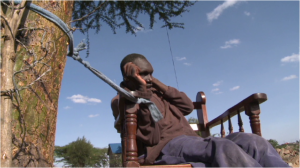 cannot be treated this way. Since the première of this documentary on CNN, Human Rights groups have lodged complaints to Kenyan president Mwai Kibaki. After all, the documentary showed repeated breaches of U.N.’s Convention of the Rights of Persons with Disabilities (CRPD), which Kenya actually ratified in 2006. But the Kenyan government is not ignorant of the problem with their mental health facilities. Government spokesman Alfred Matua admitted that the Kenyan mental health system needed massive reform and had many structural issues. It is great that the government has already acknowledged that they must reform the mental health system. However, the international community must do more than observe the situation passively and complain about UN conventions being ignored. It is easy for many of us to sit on a perch and look with disdain at the poor treatment people in Kenya with mental disabilities face at asylums or even with their family members. But just complaining about the problem will not enact change. Although the hospital staff could certainly treat patients more humanely, the root of this problem is that there is not enough investment in mental healthcare in Kenya. With other problems plaguing the country, increasing funding to accommodate more patients and to be able to treat them better, may be too low a priority for government officials. What the international community can do is increase direct funding to hospitals that are known to treat patients humanely. If these hospitals can collect more money in donations directly from aid organizations or private donors, they can expand their facilities and accommodate more patients in need. At the beginning of his documentary, David McKenzie acknowledges that viewers may find it extremely difficult to see the horrid conditions that Kenyan patients face. However, he urges viewers not to look away from the television. He proclaims that people have turned a blind eye to this problem for too long, and that by telling this story, he hopes that “the light that is shared will spark the change that many are desperate for.” The world is no longer blind to these problems. We need to spark this change not just by complaining to the Kenyan president or by citing human rights violations but by getting out our checkbooks and help give Kenya the resources to tackle a problem that has spiraled out of control.
cannot be treated this way. Since the première of this documentary on CNN, Human Rights groups have lodged complaints to Kenyan president Mwai Kibaki. After all, the documentary showed repeated breaches of U.N.’s Convention of the Rights of Persons with Disabilities (CRPD), which Kenya actually ratified in 2006. But the Kenyan government is not ignorant of the problem with their mental health facilities. Government spokesman Alfred Matua admitted that the Kenyan mental health system needed massive reform and had many structural issues. It is great that the government has already acknowledged that they must reform the mental health system. However, the international community must do more than observe the situation passively and complain about UN conventions being ignored. It is easy for many of us to sit on a perch and look with disdain at the poor treatment people in Kenya with mental disabilities face at asylums or even with their family members. But just complaining about the problem will not enact change. Although the hospital staff could certainly treat patients more humanely, the root of this problem is that there is not enough investment in mental healthcare in Kenya. With other problems plaguing the country, increasing funding to accommodate more patients and to be able to treat them better, may be too low a priority for government officials. What the international community can do is increase direct funding to hospitals that are known to treat patients humanely. If these hospitals can collect more money in donations directly from aid organizations or private donors, they can expand their facilities and accommodate more patients in need. At the beginning of his documentary, David McKenzie acknowledges that viewers may find it extremely difficult to see the horrid conditions that Kenyan patients face. However, he urges viewers not to look away from the television. He proclaims that people have turned a blind eye to this problem for too long, and that by telling this story, he hopes that “the light that is shared will spark the change that many are desperate for.” The world is no longer blind to these problems. We need to spark this change not just by complaining to the Kenyan president or by citing human rights violations but by getting out our checkbooks and help give Kenya the resources to tackle a problem that has spiraled out of control.
May 28
Unlock the Forgotten
May 27
Surfing for Equality & Peace
“Surfing soothes me. It’s always been a kind of Zen experience for me. The ocean is so magnificent, peaceful, and awesome. The rest of the world disappears for me when I’m on a wave.” -Paul Walker
Surf’s up, dude! Surfing is a sport chased after by people around the world who seek adventure or a tranquil retreat away from life’s worries. Many surfers develop a deep connection with nature while riding the ocean’s waves—some have even called it a spiritual phenomenon. Yet others find a therapeutic quality to surfing that they have not been able to experience elsewhere, reducing negative symptoms such as anger and stress in their daily lives. Whatever one’s personal reasons for taking up surfing, one thing is for sure—it has the ability generate peace in and out of the waters.
Surfing breeds a culture of oneness. It does not fuel a system of hatred or oppression. It is not affiliated with political, social, or cultural discrimination. In fact, it is now being used to bridge political and cultural gaps and cultivate a peaceful environment in the Middle East by empowering surfers to pursue their dreams, including young females. Since Hamas took over the Palestinian territory of the Gaza Strip in 2007, the rights of women have become more restricted than ever before. Freedoms that women experienced before Hamas have dissipated and rules of governance have become stricter. For example, women cannot swim without a hijab, dance, or walk around in public without a male relative. These prohibitory enforcements, in addition to the on-going conflict with Israel, have ignited regional hardships, suffering, and isolation from most of the world. Ryan discusses some of the recent political developments going on in the Gaza Strip in his latest post.
In 2010, a partnership between Gaza Surf Relief, Surfing 4 Peace, and Explore Corps collected, transported, and delivered surfing equipment to all male surfers of the Gaza Strip. After a long and complicated road to get the equipment to the Gaza Surf Club to distribute to its members, it finally happened with the assistance of the United Nations. Due to the surf boards having to go through Israel to get to Gaza, it posed no easy task and took 2 years of negotiations for Phase I of this surfing project to reach completion. However, two young girls who began pursuing surfing did not receive the same entitlement that their male counterparts did due to conservative nature of the society. These young 14 year old girls, Rawan and Shoruq Abo Ghamen, have continued surfing with the support of their families and the surfing community, breaking down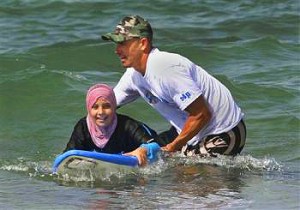 gender discrimination barriers and pioneering a social movement. You don’t think it ends there, do you?
gender discrimination barriers and pioneering a social movement. You don’t think it ends there, do you?
I didn’t think so! The NGO partnership is at it again, now seeking to implement Phase II in the summer of 2011—The Gaza Burkini Project. Surfing 4 Peace has been working with the girls, their parents, and a diverse advisory board, as well as fashion designers at Parsons the New School for Design in NYC, to create and manufacture a socially-acceptable swimsuit for the girls to maintain their modesty while hitting the waves. Once the design has been approved and executed, the Burkinis will be sent as part of a care package to Rawan and Shoruq along with surfboards and wetsuits. If interested in learning more about supporting this project, you can visit Surfing 4 Peace’s site.
I commend and applaud the surfing community for their unique contribution to encouraging non-violence through the sport of surfing and the spirit of Aloha, as well as eliminating discriminatory practices based upon gender. The citizens of the Gaza Strip have been faced with much turmoil and by having a serene escape, even if only temporary, is a wonderful thing. The physical and mental benefits of surfing have been compared to those of yoga, both of which have been described as “moving meditations.” Surfing allows individuals to savor the moment and disengage from the chaotic mind. Additionally, it gives girls hope. Hope for gender equality, and hope for a peaceful society. I do not think that these surfer girls will be met unchallenged when the project delivers; however, it encourages a spirit of friendly acceptance and a need for progressive peace.
Cynthia Castaldo-Walsh is a Program and Research Intern with the SISGI Group focused on gender-based conflict, non-violence and peacebuilding for conflict transformation, and sustainability for conflict resolution.May 27
Disabled Actors and Acting Disabled
The Absence and Authenticity of Disability in films and TV
In recent years there has been some controversy over the shortage of scripted characters with disabilities in American media and arts. Studies from the National Arts and Disability Center and the Broadcaster’s Disability Network show that although 20% of Americans between the ages of 5 and 64 experience disability, they are represented by less than 2% of characters played on television. A related issue is the absence of actors with disabilities in films. The same studies found that over one-third of persons with disabilities (PWDs) in the entertainment business believed that auditions were refused or roles were denied as a result of a disability. Although ADA regulations and non-discrimination policies prohibit discrimination based on disability, many actors and actresses with disabilities won’t disclose their conditions or ask for accommodations for fear that they won’t be hired. So, on the one hand, we have characters with disabilities that are consistently played by non-disabled actors, but on the other hand we have talented actors with disabilities with less access to agents, drama schools, and auditions, creating a smaller pool of disabled applicants for directors and producers to choose from. With these odds, the problem is not only the small number of disabled characters, but who gets to play them and how they are portrayed.
Historically, characters with disabilities in theater and films have been portrayed as fear-inspiring villains (Freddy Krueger in The Nightmare on Elm Street series and Leatherface in The Texas Chainsaw Massacre movies), or bitter and misguided antagonists (Ephialtes in 300, the phantom in The Phantom of the Opera, Elijah Price in Unbreakable, Mason Verger in Hannibal, and Batman’s two-face), or pitiable but charming heroes (as in The Hunchback of Notre Dame, or Powder). Although things have improved since the release of some of these older films, it’s still rare to see depictions of balanced, complex, and dynamic PWDs on the screen.
Even more problematic, non-disabled actors who played disabled characters have received recognition for their performances in these challenging roles, including Daniel-Day Lewis’s portrayal of a man with cerebral palsy in My Left Foot, and Frankie Muniz’s character in the Disney Channel’s Miracle in Lane 2, who wins a soap-box derby championship despite his spina bifida, and Leonardo DiCaprio’s role as Arnie Grape, who has a developmental disability in What’s Eating Gilbert Grape. In recent years, critics have raised questions over the selection of able-bodied Kevin McHale to play the role of Artie, a wheelchair-user, in Glee. In McHale’s case, it was his singing, dancing, and acting abilities that won him the part, according to the producer. There are talented actors with disabilities, and I find it hard to believe that there is no bias in the selection process. At the end of the day, a progressive and diversity-driven show like Glee still chose a non-disabled actor for the part. This leads to the questions, how is disability authentically portrayed, and who has the authority to portray it?
McHale to play the role of Artie, a wheelchair-user, in Glee. In McHale’s case, it was his singing, dancing, and acting abilities that won him the part, according to the producer. There are talented actors with disabilities, and I find it hard to believe that there is no bias in the selection process. At the end of the day, a progressive and diversity-driven show like Glee still chose a non-disabled actor for the part. This leads to the questions, how is disability authentically portrayed, and who has the authority to portray it?
During the 19th and part of the 20th centuries in America, minstrel shows popularized “blackface,” a routine in which Caucasian performers would use greasepaint or shoe polish to darken their faces and play caricatures of African Americans. Although this performance Continue reading
May 26
Opening the Gaza Strip
Who would have thought that the self-immolation of a fruit vendor in Tunisia could effect so much change within the Middle East? As the citizens of Arab states revolt, the status quo and operating procedures of many countries have been drawn into question. In the somewhat geographic center of it all, Israelis have been wondering exactly how this will affect their nation. The decision announced yesterday by the Egyptian government to permanently reopen the Rafah crossing, the main entry point from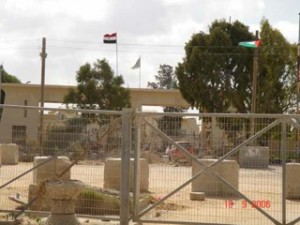 Egypt into Gaza, shed light into the future of the Egyptian-Israeli relations, who until now have shared an alliance that defines Israel’s relation to the Arab world.
Egypt into Gaza, shed light into the future of the Egyptian-Israeli relations, who until now have shared an alliance that defines Israel’s relation to the Arab world.
The Gaza Strip is home to some 1.5 million Palestinians. Since 2007, Israel, with the begrudging support of Egypt, has blockaded Gaza. Restrictions on what could enter and exit the Strip, which had been in place since 2001, were tightened severely in 2007, leading to the deterioration of the quality of life for many Palestinians living in the region. The BBC estimates that today, Gazans rely “on less than a quarter of the volume of imported supplies they received in December 2005.” It’s not hard to imagine what this drastic cut in supplies meant for the daily life of Gazans: less food, less medicine, reduced access to electricity, reduced supplies of clean water and so on.
The UN Relief and Works Agency (UNRWA) for Palestinian Refugees estimates that 80% of Gazan households rely on some type of food aid. Much of this reliance on food aid could be alleviated if Israel were to reduce the restrictions on what is being allowed into the Strip. While the restriction of materials that could be used to produce weapons is understandable, it’s wrong to block basic foodstuffs from entering the region, something Israel has repeatedly been criticized for doing. Does anyone believe that punishing 1.5 million people for the terrible actions of select terrorist organizations will really move the general Palestinian population towards a peace arrangement?
With the announcement to open the border crossing, Egypt has shown that it’s not willing to wait and see if the Israeli blockade strategy will work in time. This is the first action taken by the new Egyptian government that has truly displayed their position on the tenuous Israeli-Egyptian alliance, though the unity deal between Fatah and Hamas was arguably the precursor. With the permanent opening of the Rafah crossing, scheduled to begin this Saturday, Egypt has decided to go against Israel and allow supplies to flow openly through the crossing. A bold move, indeed.
As it stands, the alliance remains in tact. But how long will Israel continue friendly relations with a nation that is supporting a policy that Israel outright rejects? Regardless of the shaky alliance, Israel should recognize and effectively address the plight of the Palestinians living in the dirt-poor conditions of the Gaza Strip. Forcing a population to succumb to near complete reliance on aid coming from outside sources is not an effective method to building a sustainable future. On the contrary, it stokes the fires of bitterness and hatred that have been burning for years, a fire neither side seems able, or perhaps willing, to extinguish.
Now that Egypt has taken a stand, defied Israel and opened the border, the future is largely in the hands of the Palestinians. Gazans should use this event to develop trade routes with the outside world, boosting their economic status. UNRWA could then shift its mission from simply providing aid and shelter to helping Gazans build a future for themselves.
Unfortunately, the decision is not in the hands of the everyday Gazan, it is in the tenacious clutches of Hamas, who rule the Gaza Strip. I doubt that Hamas will allow this event to be the turning point in a lasting peace. Hamas has been relatively quiet since their unity deal with Fatah, but they have given no indication that they are willing to negotiate a peace treaty with Israel. On the contrary, they have reiterated their insistence on denying Israel’s existence. If Hamas maintains its terrorist credo and uses this event as a catalyst to further attacks, I don’t think anyone doubts that Israel will respond in kind, effectively destroying any benefit from the opening of the crossing.
The potential for positive change as a result of this opening is there. It’s up to the regional actors to decide whether to embrace or squander the opportunity.
Ryan Pavel is a Program and Research Intern with the SISGI Group focusing on foreign military involvement, policy and strategy into conflicts and motivations behind and impact of foreign aid. To learn more about the SISGI Group visit www.sisgigroup.orgMay 26
The International Day of U.N. Peacekeepers
This Sunday, May 29 is the International Day of United Nations Peacekeepers. Never heard of it? It’s the day that recognizes and celebrates all those who have taken part in UN peacekeeping operations led by the Department of Peacekeeping Operations (DPKO). Never heard of that? Well, it’s a department of the United Nations that is committed to maintaining international peace and security. It leads operations in countries of conflict to resolve that conflict and create a state of lasting peace.
In its 60 years of existence, UN Peacekeeping has implemented over fifty successful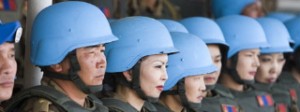 international peace operations in dozens of countries, not including the fifteen projects that are currently in progress. Simply put, UN Peacekeepers know what they’re doing and – considering the success they’ve had – they’re clearly doing something right. They have also won the Nobel Peace Prize.
international peace operations in dozens of countries, not including the fifteen projects that are currently in progress. Simply put, UN Peacekeepers know what they’re doing and – considering the success they’ve had – they’re clearly doing something right. They have also won the Nobel Peace Prize.
Staying true to the three basic principles of peacekeeping (consent of the parties, impartiality, and the non-use of force), UN Peacekeepers develop a specific strategy and budget for each operation. This allows for the highest chance of a successful operation that ends in lasting peace for the country – and consequently the world.
There’s certainly a lot to celebrate this Sunday, as peacekeeping is no simple task. In order for peace building to work, there needs to be the perfect combination of idealism, to maintain hope that peace can be achieved, and realism, to understand the challenges that get in the way. In a word filled with hate, violence, and warfare, it takes a lot of heart to believe in the possibility of peace. It takes even greater time, dedication, and hard work to create a realistic plan that can be both successful and effective.
So this Sunday, take a moment to appreciate the wonderful yet extremely difficult work that UN Peacekeepers do. Honor the 2,900 people who have died in these efforts, and support the 120,000+ people who are currently participating in operations. Not only can we learn something from the peace building strategies and accomplishments of UN Peacekeeping, but we can also be inspired by their hope for a more peaceful globe.
Do you believe that global peace can be achieved? Do you know any other organizations that have similar goals to UN Peacekeepers? Let us know what other organizations are working hard to achieve peace!
Rebecca Birnbaum is a Program and Research Intern with the SISGI Group focusing on nonviolent conflict resolution, nonprofit management, and sustainable development. She is a senior at the University of Michigan, where she studies Anthropology, Political Science, and Peace and Social Justice. To learn more about the SISGI Group visit www.sisgigroup.org.May 26
Driving for Freedom
When I was in my early teen years, I excitedly got behind the wheel of my mother’s car and slowly cruised down my driveway, up the street, and around my neighborhood for the very first time. I practiced and practiced day in and day out, regularly being praised and encouraged by friends and family alike. At 16, the all-important day had arrived. As I stood anxiously behind a long row of cars, I contemplated the freedom and independence I would have once the road test instructor got into my car and saw how beautifully I could drive. A shriek of delight and a sigh of relief came when the driving test was over and I was handed a “PASS” paper. From that moment on, my life had changed in an unequivocal way.
I wake up every morning. I brush my teeth, shower, get dressed, walk my dogs, and begin my day. I jump into my car to go to work, run errands, attend school, and visit friends and family. I generally do not think twice about this practice and the jubilation I once felt has long faded. I could not imagine life any other way. However, thousands of women around the world have never experienced the same kind of joy and privilege that I so take for granted.
In Saudi Arabia, gender often dictates every aspect of daily life—with women at the bottom of the totem pole. Some have even referred to the political and social situation in Saudi Arabia as a “gender apartheid.” You can check out Stephen’s blog post where he describes how this so-called apartheid is criticized by the international community, but how the power of counter-reform organizations have deterred women from gaining equality throughout history despite criticism.
One aspect of life affecting women in the country is the female ban on driving. This ban creates a strong reliance on women to hire expensive drivers or utilize their male relatives to shuffle them around, both of which are not always easy or possible—or fair. The women of Saudi Arabia have been raising this issue of unfairness for years, but to no avail. Recent actions led by Manal al-Sherif and a large community of supporters have empowered women to get behind the wheel and experience the freedom of mobility.
Manal al-Sherif assisted in publicly organizing a collective assemblage of Saudi women—Women2Drive Campaign—to exercise their right to drive on June 17th, 2011. Al-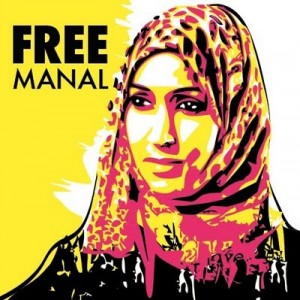 Sherif was arrested just a few days ago and is being detained in prison for her call to action, empowering Saudi women to join the peaceful protest and upload their driving videos to the internet, and posting a video of herself driving around the Eastern Region on YouTube. International and local human rights organizations and activists have scrambled to draw attention to al-Sherif’s arrest, have her released, and encourage the Saudi government to reevaluate its restrictive laws on women—particularly in this case where there are no traffic laws prohibiting women from driving.
Sherif was arrested just a few days ago and is being detained in prison for her call to action, empowering Saudi women to join the peaceful protest and upload their driving videos to the internet, and posting a video of herself driving around the Eastern Region on YouTube. International and local human rights organizations and activists have scrambled to draw attention to al-Sherif’s arrest, have her released, and encourage the Saudi government to reevaluate its restrictive laws on women—particularly in this case where there are no traffic laws prohibiting women from driving.
Will this equality-seeking movement continue to push forward? I would not be surprised if the revolutionary campaign is carried out on June 17th, despite the involuntary removal of the original Facebook group, YouTube video, and Twitter account. Several thousand supporters, men and women alike, joined the social media groups and planned on taking part in the historical event (and still do). Even more activists and supporters have become aware of the campaign due to international outrage over al-Sherif’s arrest, with social media groups reemerging to continue to raise public awareness. However, as Michelle concluded in a recent blog post about social media’s role in the Tunisian revolution, Facebook, YouTube, and Twitter cannot be considered as the spark or cessation of any social justice movement. Social media should be considered as playing a secondary, supportive role to the social, political, economic, cultural, and/or religious factors that ignite civil action. This holds true in the case of Saudi women seeking righteousness through a basic right to drive. It did not start with Manal al-Sherif, nor will it end with her. However, her courageous actions in conjunction with the power of social media have inspired and paved the way for so many other women to demand equality in Saudi Arabia and around the world.
Cynthia Castaldo-Walsh is a Program and Research Intern with the SISGI Group focused on gender-based conflict, non-violence and peacebuilding for conflict transformation, and sustainability for conflict resolution.
May 25
Curitiba A Model for Economic Development in Brazil
Brazil, with its growing economy and BRIC designation, is considered a country to watch in the global south, but few people know about the star of Brazil: Curitiba. Curitiba, capital of the Brazilian state of Paraná, is southern Brazil’s largest city and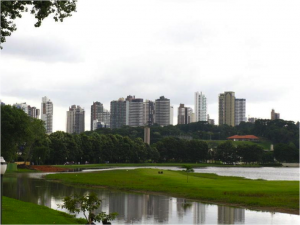 economy, with a GDP that surpasses US$30 billion and a total population of over 3.2 million. This economic powerhouse was a small backwater town just a few decades ago, but a series of reforms has made it the ‘best place to live’ in Brazil (according to Reader’s Digest)—and now other countries are hoping to adopt those reforms to improve their own economies and standards of living.
economy, with a GDP that surpasses US$30 billion and a total population of over 3.2 million. This economic powerhouse was a small backwater town just a few decades ago, but a series of reforms has made it the ‘best place to live’ in Brazil (according to Reader’s Digest)—and now other countries are hoping to adopt those reforms to improve their own economies and standards of living.
Curitiba’s most famous reform is their bus system. Rather than install an expensive (and often unreliable, as anyone who has ridden the D.C. metro or the Chicago el can attest) subway system, Curitiba’s urban planners decided to implement a Bus Rapid Transit system that was easily integrated into the city. That way they avoided the heavy costs of digging miles of tunnels and laying down tracks, as the buses can run on existing roads and so the only expenses were buying the buses and building bus stops. The buses are privately owned by 10 private bus companies, and all ten earn a profit. The companies are paid by distance traveled, not passenger volume, which allows for a balanced distribution of bus routes and helps ease congestion of major roads, as the bus operators have no incentive to hog the more populated routes. The buses are fast and are usually on time, and since they charge a flat rate regardless of distance traveled people of all income levels can afford to take the bus. Further, the buses are all color-coded and serve a variety of needs, from the yellow city street buses, to the grey express buses that run from the suburbs to downtown, to the blue interhospital buses that run between the city’s medical centers.
This Bus Rapid Transit system is just one element of the Master Plan that has helped make Curitiba one of the most powerful cities in Brazil. The Master Plan was adopted in 1968, and included plans to minimize urban sprawl, reduce congestion, and provide effective public transit—all while preserving the historic areas and increasing the number of parks and “green areas.” One of the most impressive elements of the Master Plan (besides the bus system, of course) is the way in which urban and economic development was integrated with human needs. For example, the Cambio Verde program allows poor citizens to trade their recyclables for fresh produce, a solution that reduces waste and promotes environmentalism while improving the standard of living for those of low socio-economic status. The historic blocks were restored and the buildings converted to museums, bars, restaurants, and shops, and now are some of the most bustling areas of the city; again, the economic growth provided by the businesses are combined with human needs and historic preservation. Old buses are taken over by the city and converted so they can be used for a variety of tasks, such as transportation to parks and mobile learning centers.
Other countries in the global south would do well to try to implement some of the elements of the Master Plan, which allows Curitiba to follow the age-old adage of ‘work smarter, not harder.’ By using available funds and integrating development with human needs Curitiba is so powerful that it now needs to create a second Master Plan to deal with the massive influx of immigrants. Other countries and cities in the global south can learn a lot from the Plan, as can those in the global north. Even cities in the comparatively prosperous western world could afford to adopt some provisions of the Plan, particularly aspects of the transportation system and some of the green initiatives. A lack of cheap and efficient transportation plagues many cities—and rural areas—in the global north, and so Curitiba’s Bus Rapid Transit system could be a good model for those areas as well.
Of course, it’s not a one-size-fits-all type plan; Curitiba is such a successful example because the planners understood the way the city worked and what the people needed, but every society has different needs. Still, Curitiba is a prime example of economic development, and shows that it can happen—and fast—if money is used in the right way.
Michelle Bovee is a SISGI Group Program and Research Intern focused on international affairs, economic development, and responsible tourism. To learn more about the SISGI Group visit www.sisgigroup.orgMay 24
Gift of Life
People indisputably have contrasting views on life and how to use it. Some use life to build a loving family, whereas others use it to travel the world and savor its beauties. Some use it to amass great personal wealth, fame, and material possessions, and others dedicate their lives to serving others. I am not one to pass moral judgments on how one should use their life. But in spite of all of our differences, we should all agree that life is a beautiful gift. Regardless of how we choose to use our life, it should be something we enjoy. Unfortunately, not all people are able to enjoy life. Neuropsychiatric conditions plague people around the world. Many people are unable to pursue their goals or passions because they are debilitated by depression, schizophrenia, bipolar disorder, or other conditions. They are often unable to overcome their problems because they either lack access to mental health clinicians or are too afraid to seek help. We must reduce this huge treatment gap between those who have these conditions and those who actually receive treatment. There are many avenues of decreasing this gap – increased emphasis from governments, more R&D to develop cheaper medicines, more economic incentives for talented students to pursue careers in mental health, decrease of stigma against these health conditions, etc. I will discuss these specific ways to improve health outcomes in future posts. But first, I want to bring awareness to just how serious of a problem it is.
schizophrenia, bipolar disorder, or other conditions. They are often unable to overcome their problems because they either lack access to mental health clinicians or are too afraid to seek help. We must reduce this huge treatment gap between those who have these conditions and those who actually receive treatment. There are many avenues of decreasing this gap – increased emphasis from governments, more R&D to develop cheaper medicines, more economic incentives for talented students to pursue careers in mental health, decrease of stigma against these health conditions, etc. I will discuss these specific ways to improve health outcomes in future posts. But first, I want to bring awareness to just how serious of a problem it is.
As the son of a physician and two Indian immigrants, I learned the value of medicine at an early age and saw first hand in India the many health, economic, and educational inequities in the world. Based on these prior experiences, I decided to pursue Economics, Public Policy, and Global Health at Duke. I believed that the combination of these classes should help teach me the most efficient way to maximize the gift of life amongst as many people as possible. You may wonder why I have chosen to write about mental health inadequacies. If I am seeking to attain efficiency in preserving the gift of life and decreasing health inequities around the world, surely problems such as cardiovascular disease, cancer, malaria, and TB are much more pressing than Neurosychiatric conditions. In reality, we often severely underestimate the severity of the burden of mental health disorders around the world. According to a World Health Organization report, 25% of people in the world will be affected by mental health disorders in their lifetimes. In fact, mental health disorders account for 28% of DALY’s among non-communicable diseases. Lastly, more years of life are affected by mental health disorders than cardiovascular disease and cancer. In spite of the huge burden of mental health, there is a huge gap between the amount of people with mental disorders and those who are actually treated. In fact, two-thirds of people with mental disorders never even seek medical health for their disorders.
Why does such a huge treatment gap exist between those who need help and those who actually receive it, when it is so clearly a huge problem throughout the world? One issue is a scarcity of professionals to tackle the problem. The WHO has estimated 1.18 million mental health professionals, including 55,000 psychiatrists, 628,000 nurses in mental health settings, and 493,000 psychosocial care providers are needed to treat mental disorders in 144 low- and middle-income countries. Another huge issue is that many governments do not have a focus on combating this problem. Over 40% of countries do not even have any type of mental health policy. The problem is simply ignored by policymakers in many of these countries. Finally, a huge stigma against mental health disorders exists in many places around the world. As a result, even those who have the resources to be treated for their disorders often refrain from doing so, for fear of the discrimination they will face.
Many of you who will follow my blog posts, share my desire to decrease health disparities around the world, allowing as many people as possible enjoy their gift of life. One of the most efficient ways of doing so is by increasing the emphasis of reducing and treating mental disorders. Before governments get out their pocketbooks and take this problem seriously (more than 33% of countries do not even spend 1% of their health budgets on mental health), we must lobby and convince our representatives that this is a serious problem that warrants much more attention. By raising awareness about this problem, we will see more serious measures taken by governments, more money invested into R&D, more talented students pursuing careers in mental health, and less people being stigmatized for their conditions. This in turn will lead to significantly better health outcomes in the future.
Shaunak Varma is a SISGI Group Program and Research Intern. To learn more about the SISGI Group visit www.sisgigroup.org
May 24
Iraq Aid – The Water Crisis
One of the most pressing issues the Iraqi people face today is a shortage of potable water. In 2010, the International Community of the Red Cross estimated that one in every four Iraqis did not have access to drinkable water. Iraq is known as the land of the two rivers, the Tigris and the Euphrates, which have fed Mesopotamia life giving water for thousands of years. Until relatively recently, Iraq has had an ample supply of water in spite of its vast amount of desert plains thanks to these rivers.
It wasn’t until the 1990s that Iraq began facing a severe shortage of water. When Iraqi forces invaded Kuwait in 1990, economic sanctions from around the globe combined with US military attacks on water treatment plants in Operation Desert Storm damaged Iraqi infrastructure and spurred the current water crisis. From this point on, Iraq has lacked the capability to cleanse enough water to care for its people. Hundreds of thousands of Iraqis have died since then, in part from lack of clean water. This applies in particular to young Iraqi children, who are more susceptible to water-borne diseases than adults.
of thousands of Iraqis have died since then, in part from lack of clean water. This applies in particular to young Iraqi children, who are more susceptible to water-borne diseases than adults.
After the 2003 invasion of Iraq, the water shortage became much worse, leading many Iraqis to dig their own wells in an effort to access the groundwater beneath their property. Efforts undertaken by the United States Agency for International Development (USAID) to rehabilitate Iraqi infrastructure, including water treatment centers, received criticism for failing to complete planned projects that addressed issues such as the water shortage.
So who is currently working in Iraq to make a difference with this issue? This question isn’t quite so easy to answer as it may have been 5 years ago when many countries were involved militarily in Iraq. As the security situation has improved and countries have withdrawn forces, the interest of the international community in assisting Iraqis has decreased. But as I argued in a previous post, basic needs like water and electricity must be provided if Iraq is to maintain any semblance of security and stability. A chronic shortage of water will undoubtedly continue to exacerbate tensions in the region, something Iraq cannot afford to deal with in light of the upcoming US troop withdrawal.
A website dedicated to providing a list of clean water projects in Iraq has little to show from the past few years other than continual posts that discuss the poor situation of Iraq’s water resources. If the main organizations such as USAID have moved on, now is the time for the smaller, more specialized groups to make a difference in Iraq. Veterans for Peace is one of the only organizations claiming to assist Iraqis in getting clean drinking water that is still posting updates regarding their efforts and successes.
Generosity Water and Charity: Water are two organizations that have made a difference in a number of countries around the globe when it comes to providing clean drinking water. What is stopping them from getting involved in Iraq, a country in desperate need of this resource? Though the security situation isn’t ideal, it is far improved from what it once was. As the country moves forward in relative stability, these organizations need to be encouraged to act before it is too late. The experience of the team members in these organizations combined with the expertise of local Iraqis dedicated to the cause could lead to a brighter future for all Iraqis, who deserve plentiful drinks of clean water just as much as the rest of us.



